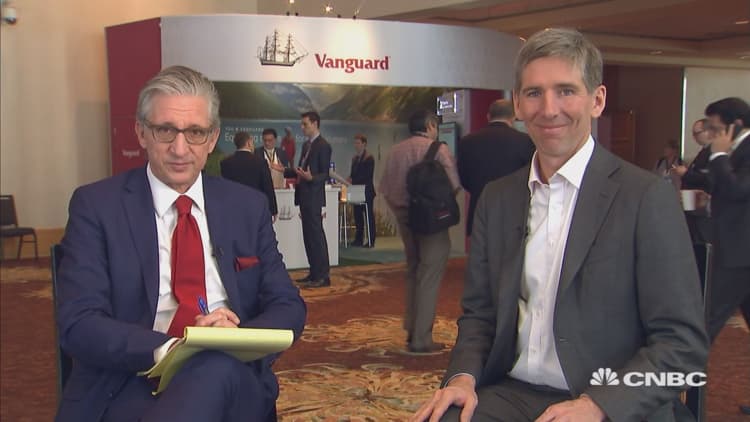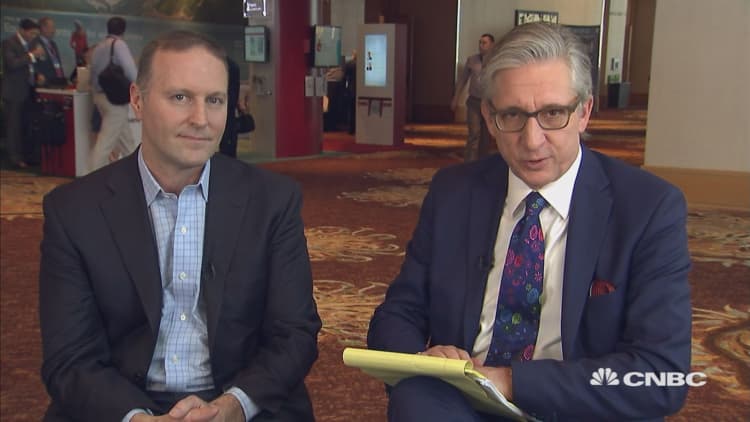


You don't have to pay a fund manager or financial advisor to create a low-cost, diversified portfolio. You can build it yourself in a matter of minutes, often commission-free, using exchange-traded funds.
"It's the greatest deal in financial history," said Matt Hougan, CEO of Inside ETFs, the world's largest exchange-traded fund conference.
For example, an investor could build a portfolio of U.S., international and emerging market stocks, along with U.S. bonds, real estate and commodities, at a total annual cost of 0.09 percent (or 9 basis points) using ETFs and pay no commissions on the trade.
That means an investment of $10,000 in this portfolio would incur $9 per year in management fees.
As an example, while the expense ratio for the Schwab U.S. Broad Market Fund is 3 basis points, a 40 percent weighting to that ETF within the diversified basket of ETFs means an investor is effectively spending 1.2 basis points of their money toward that fund: 40 percent times 3 basis points = 1.2 basis points. (See full portfolio allocation and cost breakdown below in an example using a Schwab brokerage account.)
Consider that the average expense ratio for a single traditional equity mutual fund is 68 basis points, according to the Investment Company Institute. Even a low-cost all-in-one fund, like Vanguard Target Retirement 2030, charges 15 basis points annually.
A long price war between major ETF providers BlackRock, Schwab and Vanguard has put pressure on fund sponsors to cut costs as assets rise.
Cheaper expenses are part of the reason investors have shifted more than $100 billion out of traditional mutual funds and invested nearly $1.5 trillion in ETFs since the financial crisis, according to fund researcher Morningstar.
You can use this ETF approach at several major brokers that offer commission-free ETFs, including Schwab, E-Trade, TD Ameritrade, Fidelity and Vanguard.
More from ETF Strategist:
Dow 20,000 and ETFs
You've probably never heard of this year's best commodities bet
November was a record rush into US equity ETFs. No. 2 all-time? Just as 2008 market crashed
The menus of commission-free ETFs vary widely depending on the relationship the broker has with the fund sponsors. For example, Fidelity, Schwab and Vanguard don't charge commissions on many of the ETFs they sponsor. Fidelity also offers many ETFs from BlackRock's iShares lineup commission-free.
Watch out for early exit fees on commission-free ETFs, though, if you like to adjust your portfolio more than once a month. E-Trade, Fidelity and TD Ameritrade charge you if you exit a commission-free trade within 30 days of purchase.
Look beyond price
The lowest-cost fund is not always the best fund for you.
"Don't just go with the cheaper fund," said Todd Rosenbluth, director of ETF and mutual fund research at CFRA. "It's worth paying a little more for an ETF if the fund's holdings are attractively valued or align more closely with your goals."
For example, iShares Core Dividend Growth and SPDR S&P Dividend both invest in dividend-paying stocks but track different indexes. The iShares fund has an expense ratio of 0.10 percent and gained 15.2 percent last year, while the SPDR fund charges a 0.35 percent annual fee and was up 20.3 percent in 2016.
"Understanding what's inside a fund can help sort through various options," Rosenbluth said.





